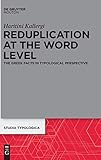Reduplication at the Word Level : The Greek Facts in Typological Perspective / Haritini Kallergi.
Material type: TextSeries: Studia Typologica [STTYP] : Beihefte / Supplements STUF - Sprachtypologie und Universalienforschung / Language Typology and Universals ; 17Publisher: Berlin ; Boston : De Gruyter Mouton, [2015]Copyright date: ©2015Description: 1 online resource (443 p.)Content type:
TextSeries: Studia Typologica [STTYP] : Beihefte / Supplements STUF - Sprachtypologie und Universalienforschung / Language Typology and Universals ; 17Publisher: Berlin ; Boston : De Gruyter Mouton, [2015]Copyright date: ©2015Description: 1 online resource (443 p.)Content type: - 9783110369588
- 9783110393095
- 9783110365597
- Greek language, Modern -- Phonology
- Greek language, Modern -- Reduplication
- Linguistics and Semiotics -- Levels of Linguistic Analysis -- Morphology
- Linguistics and Semiotics -- Levels of Linguistic Analysis -- Syntax
- Linguistics and Semiotics -- Theoretical Frameworks and Disciplines -- Linguistic Typology
- Typology (Linguistics)
- LANGUAGE ARTS & DISCIPLINES / Linguistics / General
- Constraints
- Modern Greek
- Morphosyntax
- Total Reduplication
- 658.1 23
- PA1050
- online - DeGruyter
- Issued also in print.
| Item type | Current library | Call number | URL | Status | Notes | Barcode | |
|---|---|---|---|---|---|---|---|
 eBook
eBook
|
Biblioteca "Angelicum" Pont. Univ. S.Tommaso d'Aquino Nuvola online | online - DeGruyter (Browse shelf(Opens below)) | Online access | Not for loan (Accesso limitato) | Accesso per gli utenti autorizzati / Access for authorized users | (dgr)9783110365597 |
Frontmatter -- Acknowledgments -- Abstract -- Contents -- List of Conventions -- List of Abbreviations -- 1. Introduction -- Part I: Review of the literature -- 2. Overview of the Greek literature: how TR is presented in Greek studies, grammars and dictionaries -- 3. TR from a theoretical and typological perspective -- Part II: Data and types of TR in MG -- 4. Word classes and the functions/meanings of TR: correlations, constraints and preferences -- 5. Phonological aspects – the role of intonation in TR in MG -- Part III: The status and distribution of TR in MG -- 6. The status of TR in MG -- 7. TR vs. other types of lexical and/or grammatical formations -- 8. Functional equivalences and the semantic/ pragmatic distribution of TR -- 9. Conclusions and issues for further research -- References -- Appendix A: The meanings/functions of Total Reduplication cross-linguistically: a list -- Appendix B: The Sentence Completion Task -- Appendix C: The phonological experiment: the texts and divergent intonation patterns -- Appendix D: A typology of reduplicative idioms and “syndetic” reduplication constructions in MG -- Appendix E: Glossary of TR expressions in this dissertation -- Index of Authors -- Index of Languages -- Index of Subjects
restricted access online access with authorization star
http://purl.org/coar/access_right/c_16ec
Contrary to earlier approaches, this study suggests that Modern Greek (MG) is a language that exhibits reduplication, in the form of Total Reduplication (TR). The analysis addresses the morphosyntactic, phonological, semantic and pragmatic aspects of the types of TR in MG, and the constraints and/or preferences of speakers concerning their use. The typology of TR focuses on four cross-linguistically common meanings/functions, identified as the intensive, the contrastive, the distributive and the iterative. Part of the analysis of these functional types is based on data that come from two experiments with native speakers; the one confirms or refines earlier assumptions on to the relation of the above meanings/functions with word classes and semantic features of words; the other clarifies the idea of prosodic unity in TR and sheds light into various aspects of the relation of intonation with the interpretation of TR constructions. Also, the formal and lexical constraints on the use of TR are discussed with respect to the status of TR (particularly, the "grammatical"-"lexical" opposition). In general, TR seems to be a borderline case between grammar and the lexicon and a heterogeneous category, in that it involves grammatical, pragmatic and lexical construction types. However, the constructions in question meet highly specific criteria for their status as TR types and the process is productive and considerably regularized (rule-governed) in MG. In this sense, TR should not be merely taken as a strategy for "emphasis", but should be systematically represented in grammar textbooks.
Issued also in print.
Mode of access: Internet via World Wide Web.
In English.
Description based on online resource; title from PDF title page (publisher's Web site, viewed 25. Jun 2024)


